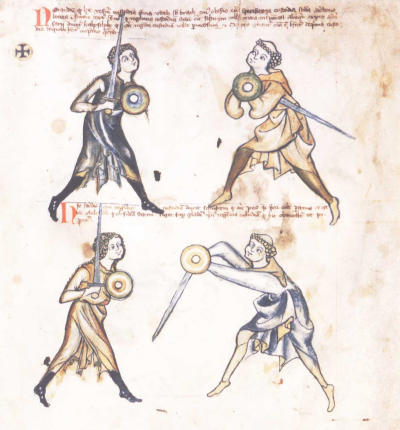The Walpurgis Fechtbuch: An Inheritance of Constantinople?
By Timothy Dawson
Arms & Armour, Vol.6:1 (2009)
 Introduction: The primacy of the Walpurgis Fechtbuch (Royal Armouries I.33) as the earliest surviving illuminated book giving instruction on individual combat has generated a great deal of discussion about why it was compiled, and where the techniques depicted came from. Much of this is quite speculative, yet there are early sources which suggest a historical background which is simultaneously of suffi cient antiquity and suffi cient sophistication as to be a plausible point of origin for the I.33 style.
Introduction: The primacy of the Walpurgis Fechtbuch (Royal Armouries I.33) as the earliest surviving illuminated book giving instruction on individual combat has generated a great deal of discussion about why it was compiled, and where the techniques depicted came from. Much of this is quite speculative, yet there are early sources which suggest a historical background which is simultaneously of suffi cient antiquity and suffi cient sophistication as to be a plausible point of origin for the I.33 style.
In his historical introduction to the facsimile edition, Jeffrey Forgeng observed that the style of I.33 is significantly different from other early examples of sword and buckler combat, yet one that ‘enjoyed a long history in the German-speaking world’ and ‘appears to spring fully armed from the heads of its creators’. An opinion implicit in Forgeng’s comments, and in the writings and practice of many of those now working to reconstruct the techniques, is that the manuscript represents a complete system. This is far from the truth. As Forgeng notes, the target areas are very circumscribed — there are no blows to the torso or lower areas, and the arms are almost entirely ignored. In fact, the targeting and blow forms represented are even more restricted than that. Virtually all the basic attacks, especially from guards 2 to 5 are ignored. There are few simple open cuts. The text states this explicitly on page 18, avoiding an open cut in favour of more complex and ‘stylish’ technique of one on the opposite side.
Further, while the head is understandably preferred as a target, there are no ‘down-right blows’ (to borrow a phrase from George Silver), almost all the cuts concluding an encounter are executed over a very short arc and often upward. Such blows would certainly end a bout effectively in the sort of civilian context depicted, yet would be very unlikely to do life-threatening injury.
The same is largely true of all the cuts depicted in the manuscript. The lower power of the blows in the technique points to another observation — this style would be ineffective against any of the armour of the period. Thus, the Walpurgis Fechtbuch style is a veneer of sophisticated techniques designed for polite, and generally non-lethal, civilian dueling.

Click here to read this article from Maney Publishing
See also: Royal Armouries selling sponsor copies of the world’s oldest surviving fight book!
The Walpurgis Fechtbuch: An Inheritance of Constantinople?
By Timothy Dawson
Arms & Armour, Vol.6:1 (2009)
In his historical introduction to the facsimile edition, Jeffrey Forgeng observed that the style of I.33 is significantly different from other early examples of sword and buckler combat, yet one that ‘enjoyed a long history in the German-speaking world’ and ‘appears to spring fully armed from the heads of its creators’. An opinion implicit in Forgeng’s comments, and in the writings and practice of many of those now working to reconstruct the techniques, is that the manuscript represents a complete system. This is far from the truth. As Forgeng notes, the target areas are very circumscribed — there are no blows to the torso or lower areas, and the arms are almost entirely ignored. In fact, the targeting and blow forms represented are even more restricted than that. Virtually all the basic attacks, especially from guards 2 to 5 are ignored. There are few simple open cuts. The text states this explicitly on page 18, avoiding an open cut in favour of more complex and ‘stylish’ technique of one on the opposite side.
Further, while the head is understandably preferred as a target, there are no ‘down-right blows’ (to borrow a phrase from George Silver), almost all the cuts concluding an encounter are executed over a very short arc and often upward. Such blows would certainly end a bout effectively in the sort of civilian context depicted, yet would be very unlikely to do life-threatening injury.
The same is largely true of all the cuts depicted in the manuscript. The lower power of the blows in the technique points to another observation — this style would be ineffective against any of the armour of the period. Thus, the Walpurgis Fechtbuch style is a veneer of sophisticated techniques designed for polite, and generally non-lethal, civilian dueling.
Click here to read this article from Maney Publishing
See also: Royal Armouries selling sponsor copies of the world’s oldest surviving fight book!
Related Posts
Subscribe to Medievalverse